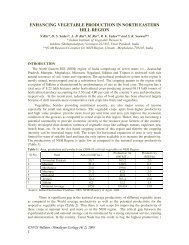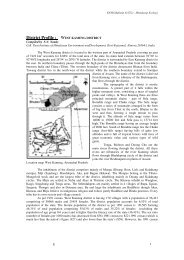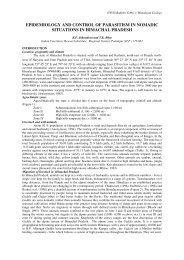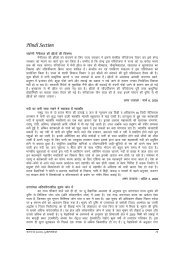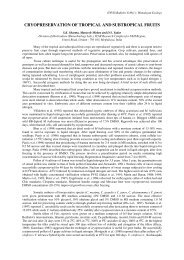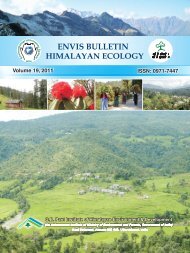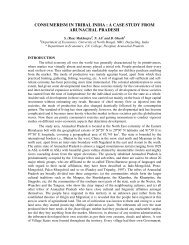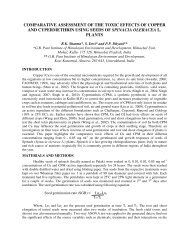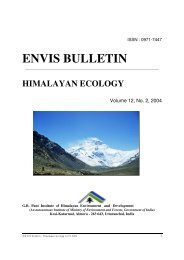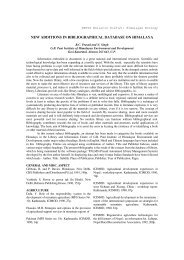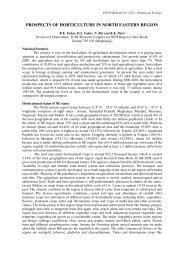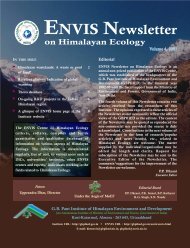Envis bulletin vol 12 1 - ENVIS Centre on Himalayan Ecology
Envis bulletin vol 12 1 - ENVIS Centre on Himalayan Ecology
Envis bulletin vol 12 1 - ENVIS Centre on Himalayan Ecology
Create successful ePaper yourself
Turn your PDF publications into a flip-book with our unique Google optimized e-Paper software.
Pumpkin varieties abound in number with variati<strong>on</strong> in fruit size, fruit skin, flesh colour<br />
thickness, sweetness, etc. The wild species Cucumis hardwickii, the likely progenitor of cultivated<br />
cucumber, is found growing in natural habitats in the foothill of Himalayas and NE regi<strong>on</strong> particularly<br />
in Meghalaya. C. sativus var. sativus is cultivated all North Eastern regi<strong>on</strong> in tropical and subtropical<br />
c<strong>on</strong>diti<strong>on</strong>s. Am<strong>on</strong>g gourds, in North Eastern regi<strong>on</strong> maximum variability has been recorded for bottle<br />
gourd in fruit shape and size. The NE regi<strong>on</strong> has rich diversity in genetic resources of ridge gourd (L.<br />
acutangula) and sp<strong>on</strong>ge gourd (L. cylindrica). Small as well as large sized forms of bitter gourd are<br />
also available.<br />
Crucifers: These are essentially cruciferous vegetables namely cauliflower, cabbage, knolkhol, etc.,<br />
introduced from the days of East India Company in 14 th -15 th century when European traders visited<br />
this regi<strong>on</strong> (Seshadri and Srivastava, 2002). Variability in Indian cauliflower widely exists in Assam<br />
and Meghalaya.<br />
Leguminous vegetables: A wide variability of French bean, cowpea and Indian bean is found in the<br />
various parts of the regi<strong>on</strong> (Table 7). In French bean, climbing or pole type is popular am<strong>on</strong>g the<br />
tribals since it is used for mix cropping with maize, the stem of which act as the support for the bean.<br />
One of the interesting species of Vigna namely V. vexillata is grown by the tribals of Tripura. It is a<br />
legume cum tuber crop with much variati<strong>on</strong> in edible tubers (Arora and Pandey, 1996). Sword bean<br />
(Canavalia ensiformis (L) DC) of papili<strong>on</strong>aceae family is also cultivated <strong>on</strong> limited scale in the North<br />
Eastern regi<strong>on</strong> (CSIR, 1950). Winged bean is c<strong>on</strong>fined in humid sub tropical parts of NE regi<strong>on</strong><br />
(Sarma, 2001).<br />
Table 7. Diversities of vegetable legumes in North East India.<br />
Cultivates species<br />
Diversities in Wild related species<br />
cultivars<br />
Sem- Dolichos lablab <str<strong>on</strong>g>12</str<strong>on</strong>g> Dolichos falcatus , D. bifilorus<br />
French bean- Phaseolus vulgaris 14 -<br />
Sword bean-Canavalia ensiformis 02 Canavalia gladiata<br />
Leafy vegetables: The important leafy vegetables include lai (Brassica juncea), lafa (Malva<br />
verticillata), palak (Spinacea oleracea). In additi<strong>on</strong> to these a wide variety of indigenous leafy<br />
vegetables are also available. These are amaranth (Amaranthus spp), puroi sag (Vasella rubra and B.<br />
alba), sorrel (Rumex rasicarius), etc. Other indigenous leafy vegetables used occasi<strong>on</strong>ally are<br />
jilmilsag (Chenopodium album) and Kalmou sag (Ipomea reptans). Amaranthus viridis, A. lividus, A.<br />
retroflexus and A. spinosus are important leafy types grown in North East India (Sarma, 2001).<br />
Tuber and rhizomatus crops: Based <strong>on</strong> the colour and the skin to broad types of sweet potato are<br />
grown in the regi<strong>on</strong>. These are the white skinned and the red skinned variety. A number of dioscorea<br />
species alata, bulbifera, brevipetiolata, esculenta, hamilt<strong>on</strong>ii, hispida, kama<strong>on</strong>ensis, nummularia,<br />
pentaphylla, puber and quinata were recorded in the Regi<strong>on</strong>. D. hamilt<strong>on</strong>ii occurs in humid forests of<br />
NE hills(Sarma, 2001). Varieties of tapioca or cassava like M-4 and hybrids H-97, H-165, H-226 have<br />
also been cultivated to some extent. In colocasia also there is a wide variability even with in <strong>on</strong>e<br />
species such as Colocasia esculenta (Sarma, 2001).<br />
Lesser-known vegetables: In additi<strong>on</strong> to the above there are a large number of indigenous vegetable<br />
crops that are used particularly by the tribal populati<strong>on</strong>. Maximum such varieties are available in<br />
Arunachal Pradesh. Tree bean (Parkia roxburghii G. D<strong>on</strong>.) is <strong>on</strong>e of the most comm<strong>on</strong> of<br />
multipurpose tree species in Manipur and Mizoram (Kumar et al., 2002). In the hilly areas tree tomato<br />
8<br />
E N V IS <str<strong>on</strong>g>Centre</str<strong>on</strong>g>, G B P IH E D



